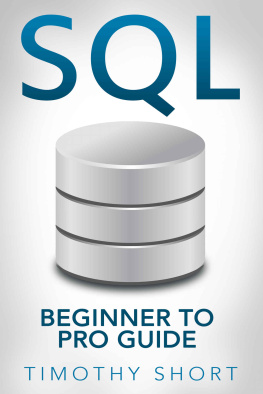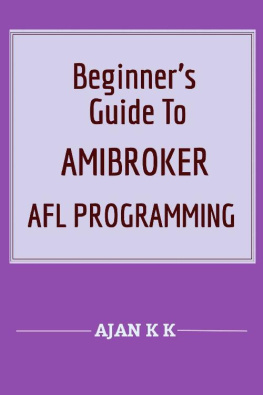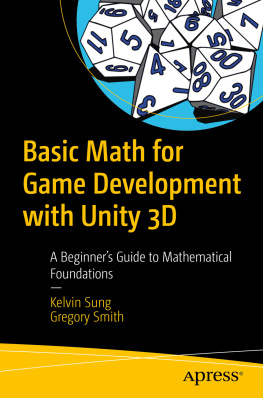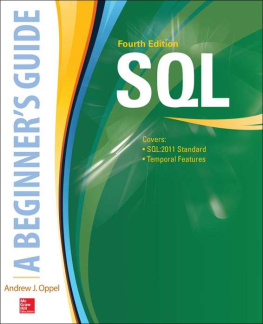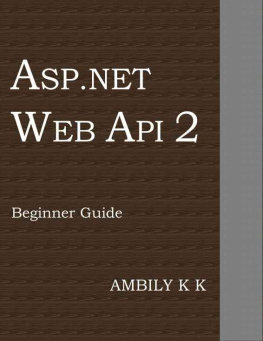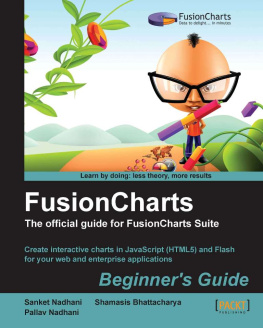Short - SQL: Beginner to Pro Guide
Here you can read online Short - SQL: Beginner to Pro Guide full text of the book (entire story) in english for free. Download pdf and epub, get meaning, cover and reviews about this ebook. year: 2016, publisher: UNKNOWN, genre: Home and family. Description of the work, (preface) as well as reviews are available. Best literature library LitArk.com created for fans of good reading and offers a wide selection of genres:
Romance novel
Science fiction
Adventure
Detective
Science
History
Home and family
Prose
Art
Politics
Computer
Non-fiction
Religion
Business
Children
Humor
Choose a favorite category and find really read worthwhile books. Enjoy immersion in the world of imagination, feel the emotions of the characters or learn something new for yourself, make an fascinating discovery.
- Book:SQL: Beginner to Pro Guide
- Author:
- Publisher:UNKNOWN
- Genre:
- Year:2016
- Rating:5 / 5
- Favourites:Add to favourites
- Your mark:
- 100
- 1
- 2
- 3
- 4
- 5
SQL: Beginner to Pro Guide: summary, description and annotation
We offer to read an annotation, description, summary or preface (depends on what the author of the book "SQL: Beginner to Pro Guide" wrote himself). If you haven't found the necessary information about the book — write in the comments, we will try to find it.
SQL: Beginner to Pro Guide — read online for free the complete book (whole text) full work
Below is the text of the book, divided by pages. System saving the place of the last page read, allows you to conveniently read the book "SQL: Beginner to Pro Guide" online for free, without having to search again every time where you left off. Put a bookmark, and you can go to the page where you finished reading at any time.
Font size:
Interval:
Bookmark:
SQL Beginner to Pro Guide By Timothy Short
Copyright 2016 by DCB Web Trading Ltd___________ - All rights reserved. This document is geared towards providing exact and reliable information in regards to the topic and issue covered. The publication is sold with the idea that the publisher is not required to render accounting, officially permitted, or otherwise, qualified services. If advice is necessary, legal or professional, a practiced individual in the profession should be ordered. - From a Declaration of Principles which was accepted and approved equally by a Committee of the American Bar Association and a Committee of Publishers and Associations. In no way is it legal to reproduce, duplicate, or transmit any part of this document in either electronic means or in printed format.
Recording of this publication is strictly prohibited and any storage of this document is not allowed unless with written permission from the publisher. All rights reserved. The information provided herein is stated to be truthful and consistent, in that any liability, in terms of inattention or otherwise, by any usage or abuse of any policies, processes, or directions contained within is the solitary and utter responsibility of the recipient reader. Under no circumstances will any legal responsibility or blame be held against the publisher for any reparation, damages, or monetary loss due to the information herein, either directly or indirectly. Respective authors own all copyrights not held by the publisher. The information herein is offered for informational purposes solely, and is universal as so.
The presentation of the information is without contract or any type of guarantee assurance. The trademarks that are used are without any consent, and the publication of the trademark is without permission or backing by the trademark owner. All trademarks and brands within this book are for clarifying purposes only and are the owned by the owners themselves, not affiliated with this document.
Table of Contents
If you are using SQL for your website, then you will be especially interested in how to properly program to prevent malicious hackers from destroying your database with an SQL injection! Dont know what that is? Well, its nasty and we can show you how to prevent it. This book includes everything from SQL SELECT to SQL WILDCARDS, and even how to create your own database and recommended data types, and everything in between! Thanks again for choosing this book, I hope you enjoy it!
In order to build a website that shows information from a database, you will need the following: An RDBMS program like SQL Server, MySQL, or MS Access. Use server side scripting like PHP or ASP Use SQL to obtain the data you want Use HTML/CSS What is RDBMS? Relational Database Management Systems are the basis for SQL, as well as all modern database systems, like IMB DB2, MS SQL Server, Oracle, Microsoft Access, and MySQL. The data contained within an RDBMS is stored in what is called tables, which are collections of related data placed in columns and rows.
Throughout the tutorials you will see here, we will be working with the Northwind sample database. This is included in MS SQL Server and MS Access. Below you will find a selection from the table named Customers. 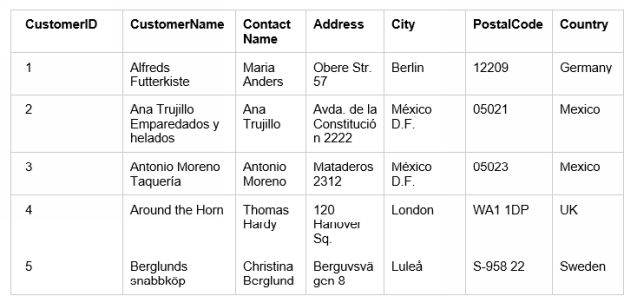 (The above table from the Northwind sample database contains five records (rows) and seven columns. Each record pertains to one customer, and each column pertains to data on that customer.) Statements Most actions performed on a database are done by utilizing SQL Statements. In order to select all records in the Customers table, use the following statement: SELECT * FROM Customers ; When doing this, you will see that rather than just 5 rows, you get the complete list of customers in the table.
(The above table from the Northwind sample database contains five records (rows) and seven columns. Each record pertains to one customer, and each column pertains to data on that customer.) Statements Most actions performed on a database are done by utilizing SQL Statements. In order to select all records in the Customers table, use the following statement: SELECT * FROM Customers ; When doing this, you will see that rather than just 5 rows, you get the complete list of customers in the table.
SQL keywords are not case sensitive, that means that SELECT = select = Select. However, for the sake of continuity, we will use all uppercase for all SQL keywords. Semicolon Usage: The use of a semicolon at the end of each SQL statement is required by some database systems. This is the standard practice for separating each SQL statement when the database system allows more than one statement to be executed in the same server call. We will be using a semicolon at the end of each statement. Important and Common SQL Commands: SELECT - extract database data UPDATE - updates database data DELETE - deletes database data INSERT INTO - inserts new database data CREATE DATABASE - creates new database ALTER DATABASE - modifies database CREATE TABLE - creates a table ALTER TABLE - modifies a table DROP TABLE removes or deletes a table CREATE INDEX - creates search key or index DROP INDEX - deletes index
Once used, you will see the results displayed in what is called a result-set, or a result table. SQL SELECT Syntax: SELECT column_name,column_name FROM table_name; And SELECT * FROM table_name; Again, we are using the Northwind sample database. Below is a selection of Northwinds Customers table:  The following is an example of selecting columns. This SQL Statement selects the CustomerName and City columns: SELECT CustomerName,City FROM Customers; Number of Records: 91
The following is an example of selecting columns. This SQL Statement selects the CustomerName and City columns: SELECT CustomerName,City FROM Customers; Number of Records: 91  (This example only contains the first five cities that would be listed in the Northwind sample database.) Using this statement will provide you with a results table containing a complete list of all customers in one column, and their cities in the other. Alternately, as seen before, you can select all columns in the table titled Customers by using this statement: SELECT * FROM Customers; Navigating in a Result Table Navigation in the result-set with programming functions is allowed in most database software systems.
(This example only contains the first five cities that would be listed in the Northwind sample database.) Using this statement will provide you with a results table containing a complete list of all customers in one column, and their cities in the other. Alternately, as seen before, you can select all columns in the table titled Customers by using this statement: SELECT * FROM Customers; Navigating in a Result Table Navigation in the result-set with programming functions is allowed in most database software systems.
Font size:
Interval:
Bookmark:
Similar books «SQL: Beginner to Pro Guide»
Look at similar books to SQL: Beginner to Pro Guide. We have selected literature similar in name and meaning in the hope of providing readers with more options to find new, interesting, not yet read works.
Discussion, reviews of the book SQL: Beginner to Pro Guide and just readers' own opinions. Leave your comments, write what you think about the work, its meaning or the main characters. Specify what exactly you liked and what you didn't like, and why you think so.

